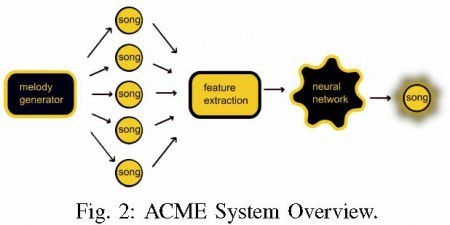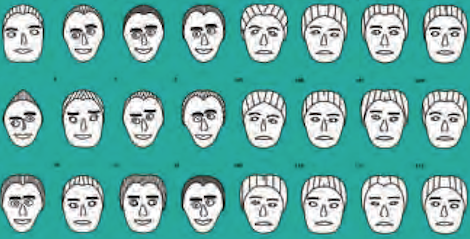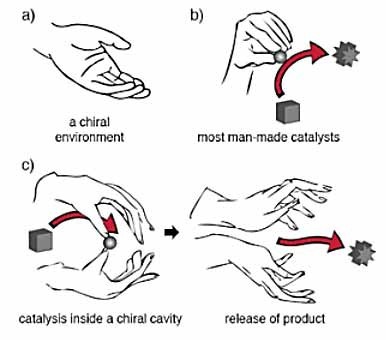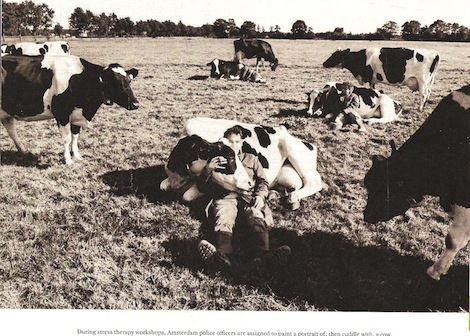Marc Abrahams's Blog, page 567
June 17, 2012
Groucho Running (Locomotion, part 1)
Please observe the unusual locomotive behaviour which begins at around 55 seconds into this video – when Groucho Marx starts to run.
Groucho is displaying a behaviour which scientists now call ‘Groucho Running’ *see note. But Groucho was by no means the first to develop this unusual gait. Take, for example the Tinamou. It also performs Groucho Running, and presumably has done so for many thousands of years. The trait has not remained under-investigated. A team from Ohio University, US, encouraged Tinamous to run or a treadmill whilst they were they were being filmed with a high speed camera. Subsequent evaluations of the video showed that :
“Kinetic energy and gravitational potential energy fluctuate in phase across speeds ranging from 0.6 –2.7 m/s, and external mechanical energy recovery by inverted pendulum mechanisms is poor (generally_15%). These results are consistent with bouncing mechanics typical of runs, although video records illustrate a lack of an aerial phase. This suggests that tinamous are “Groucho running,” a gait best described for humans in which high limb compliance limits the elevation of the center mass at midstance.“
The details of the experiment were published the Journal of Morphology, 260(3):297. See: “Groucho Running” in Tinamous. (Scroll to page page 24 in the .pdf)
* Note: As far as Improbable can discover, the term first appeared in the Journal of Applied Physiology, June 1, 1987.
Teaser: This video, where Groucho talks about pigeons, neatly dovetails into the next article in this series – but why? Find out soon …

June 16, 2012
The Further Adventures of Malcolm Hole
 Malcolm Hole‘s [pictured here] new publication is perhaps his most titillatingly titled:
Malcolm Hole‘s [pictured here] new publication is perhaps his most titillatingly titled:
“Heavy metal, sex and granites: Crustal differentiation and bioavailability in the mid-Proterozoic,” John Parnell, Malcolm Hole, Adrian J. Boyce, Samuel Spinks and Stephen Bowden, Geology, epub June 8, 2012. The authors are at the University of Aberdeen and at Scottish Universities Environmental Research Centre in Glasgow.
Second place on that list would go to:
“The mineral chemistry and petrology of Tertiary pitchstones from Scotland,” R.J. Preston, H.J. Hole, J. Still and H. Patton, Transactions of the Royal Society of Edinburgh. Earth Sciences, vol 89, 1988, pp. 95-111.
(Thanks to investigator Tom Gill for bringing this to our attention.)

June 15, 2012
Sperm can’t smell, says Timo
A report from Max-Planck-Gesselschaft, highlighting research by Timo Strünker [pictured here, and to whom the report directs inquiries for further info] and friends, says:
Sperm cannot smell.
[February 28, 2012] According to a 2003 study by German and American scientists, a component of the Lily of the Valley scent known as Bourgeonal alters the calcium balance of human sperm and attracts the sperm. The “Lily of the Valley phenomenon” – also the title of a book about smelling – was born as a result of this discovery that sperm act as swimming olfactory cells which follow a “scent trail” laid by the egg. However, a detailed explanation for the Lily of the Valley phenomenon remained illusive as neither Bourgeonal nor other scents could be identified in the female sex organ. Scientists from the caesar research centre in Bonn, an Institute of the Max Planck Society, have now discovered that sperm do not function like olfactory cells – a finding that casts doubt on the assumption that scents play a role in fertilisation.
The report is:
Brenker C, Goodwin N, Weyand I, Kashikar ND, Naruse M, Krähling M, Müller A, Kaupp UB, Strünker T., “The CatSper channel: a polymodal chemosensor in human sperm.“ EMBO J. epub February 21, 2012. doi: 10.1038/emboj.2012.30.
(Thanks to investigator Don Davis for bringing this to our attention.)

Improbable Research on “Science Friday” today: Faces
I’m going to be on NPR’s Science Friday program again today, discussing Chernoff faces.
This will be in Hour 2 of the program, in the final ten minutes. Listen on an NPR station, or online.
Here’s Herman Chernoff‘s original study [with a link to a PDF of the entire thing]:
“The Use of Faces to Represent Points in K-Dimensional Space Graphically,” Herman Chernoff, Journal of the American Statistical Association, vol. 68, no. 342, 1973,
pp. 361–8.

June 14, 2012
The Clever Lab’s Catalytic Coordination Chemistry
Few would say that the construction of multiple nano-engineered cavities for the immobilization of catalytically active transition metals was a non-trivial task. We are talking clever technology here. And appropriately perhaps, such is the domain of Junior Professor Dr. Guido Clever (of the Inorganic Chemistry Dept., Göttingen University, Germany) who has his own laboratory at the university, aptly named ‘The Clever Lab’.
Here’s a graphic example of the lab’s work :
“Molecular cages and capsules provide nanoscopic environments which can be used as the smallest imaginable reaction flasks. Immobilization of catalytically active entities such as transition metals inside these engineered cavities is envisioned to lead to a promising new class of catalysts on the long way to artificial systems with enzyme-like substrate specificity, selectivity and turn-over.”
More Clever stuff: A walnut-shaped supramolecular knot that ties itself!

June 13, 2012
Marginal images: Medieval trumpet and voiding
Peculiar drawings in the margins enliven a manuscript, made in or around the year 1350, of Jacques de Longuyon‘s poem ” Les Voeux du Paon” (English translation: “Vows of the Peacock”). The Morgan Library owns a copy (Morgan Library MS G 24) and has put some of these images online. Here are a few, each with a description provided by the library:
Fol. 001r, Man playing trumpet through anus : margin, right.
Fol. 003v, Man urinating and defecating : margin, left.

Cow-cuddling by cops, in Amsterdam, sociologically
“During stress therapy workshops, Amsterdam police officers are assigned to paint a portrait of, then cuddle with, a cow,” says the caption to this photo. A November 1, 2006 article in Mother Jones tells some of the background. The Sociological Images web site features the photo itself:
(Thanks to investigator G. Jules Reynolds for bringing this to our attention.)
BONUS (not quite related): Unexpected cow-birthing at a soccer match in Leiden, the cows being present to supply the fuel for a “predict where on the field a cow will deposit a pat” contest

June 12, 2012
A curious book review
I sent New Scientist magazine this letter, which they published in their June 6, 2012 issue. Curiously (and probably rushing stupidly when I typed the letter), I managed to confound Herr Schrodinger of cat fame with Herr Heisenberg, he of the uncertainty:
Your review of Philip Ball’s book Curiosity (19 May, p 50) ends: “Yet for all its erudition, his book does not quite succeed in capturing the difference between Nobel and Ig Nobel prizewinning curiosity.”
Nobel prizes recognise (in theory and usually in fact) curiosity that led to extremely good things. Ig Nobel prizes recognise curiosity that made people laugh, then think – regardless of whether the outcome was good or bad, valuable or worthless.
Curiosity sometimes leads to Nobel prizes. Sometimes it kills cats. Sometimes it does both. And thanks to (Nobel laureate) Werner Heisenberg’s curiosity, we suspect it may do both and neither.
The review seems to imply that curiosity that leads to good outcomes is good. The best tool for identifying that kind of curiosity, I am told, is hindsight.
—Marc Abrahams, Cambridge, Massachusetts, founder of the Ig Nobel Prize ceremony

Marginal image: Man with his rear to a chess game
Here is another of the peculiar drawings that enliven the margins of a manuscript, made in or around the year 1350, of Jacques de Longuyon‘s poem “ Les Voeux du Paon” (English translation: “Vows of the Peacock”).The Morgan Library owns a copy (Morgan Library MS G 24) and has put some of these images online. Here are a few, each with a description provided by the library:
Fol. 025v, Cassamus: Scene, upsetting Chess Game : miniature. Note the man at the left.

The ACME Country-Music Generator
Amazing as it may seem, algorithmic methods for generating music go back at least as far as 1757 (see: Musikalisches Würfelspiel). But algorithmic methods for generating US ‘Country Music’ are far more recent.
Indeed, Jim Suruda and professor Norman Carver of the Department of Computer Science, Southern Illinois University, Carbondale IL, USA, are still in the process of refining the development of an Artificial-Intelligence-based software application called the ‘Automated Country Music Engine’ (ACME).
The software not only :
• Generates melodies
• Adds chord accompaniment
• Writes MusicXML
• Reads existing MusicXML
• Extracts features from MusicXML
• Trains a neural network to rank songs
but it then also goes on to :
• Evaluate generated songs.
“If our project is successful, “ explain the developers, “ the top-rated songs the system generates should be of equal quality to those composed by a human expert.” To sum up:
“As the system becomes more mature, we intend to assemble a panel of human listeners to determine if their rankings of generated melodies agree with those of alternative evaluation architectures. We also intend to run the system for an extended period to see if the generator is able to produce a work of high quality. Although our work is at an early stage, we are encouraged that ACME might be able to recognize a musical gem inside a heap of low-scoring rubble.”
Details of ACME were presented at ICAI’11, The 2011 International Conference on Artificial Intelligence, and the paper can be read in full here : Towards an Automated Composer Of Popular Country Music.
BONUS:
Internet-based audio files of some of ACME’s output have recently been made available by researcher Jim Suruda. via SoundCloud.
Notes:
1) Firefox and Safari users may find the SoundCloud site functionally challenged. Try iExplorer instead.
2) The music doesn’t immediately come-across as being particularly ‘Country’ – but if a musical arranger re-jigged the score for acoustic guitar, banjo, drums, bass, and pedal-steel, it might well do.
3) ACME doesn’t write lyrics as yet. But this site – by an astonishing co-incidence also called ACME - does (reload page for new lyrics)

Marc Abrahams's Blog
- Marc Abrahams's profile
- 14 followers



























